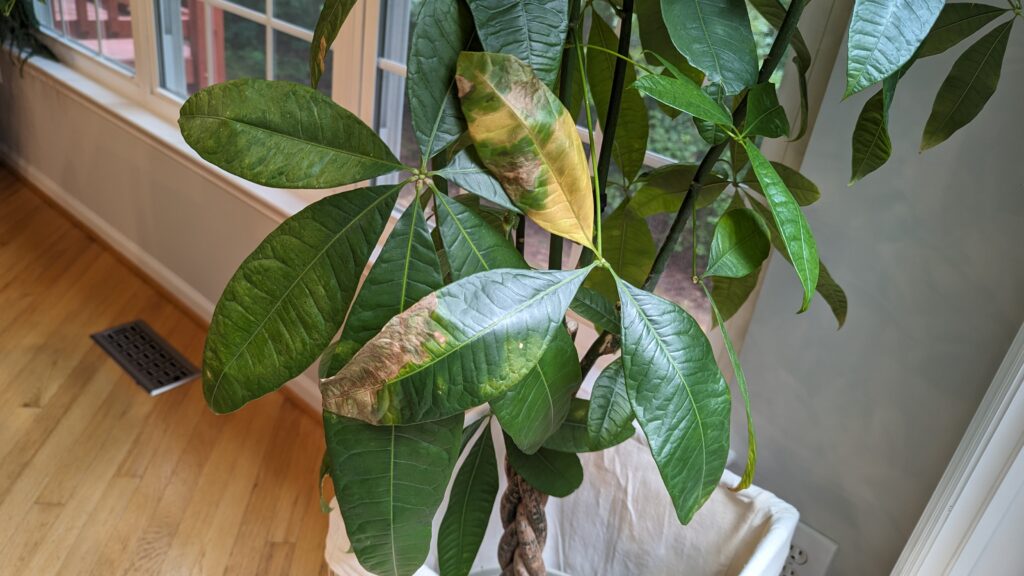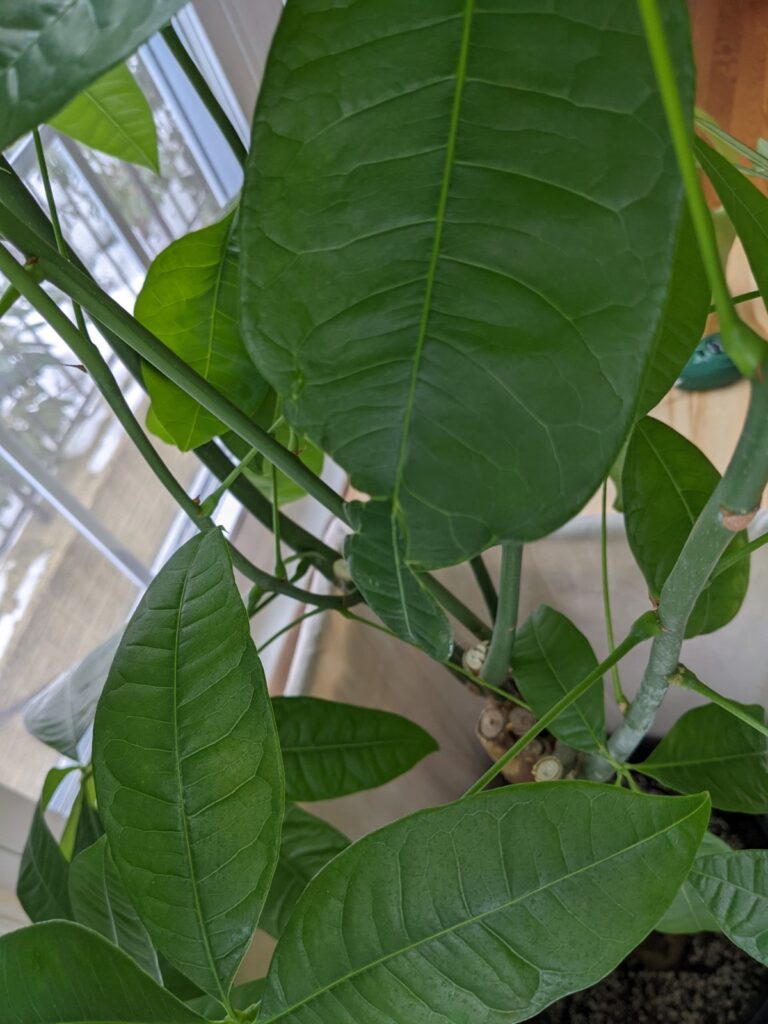Money Trees, also called Pachira Aquaticas, are popular houseplants. They are one of the three go to office plants (Money Trees, Pothos, and Snake Plant). Probably because they are all very easy to care for. They’re also easy to come by as I have seen small ones sold in the floral section at the grocery store, and larger ones can be found at plant nurseries and sometimes home improvement stores. Money Trees are often sold as several trunks braided together in one single pot which can make watering them trickier because there are multiple plants in one pot. Generally speaking, Money Trees are easy to care for, but that doesn’t mean problems don’t arise. In this post, I’ll cover the signs of and underwatered Money Tree and what you can do to fix it. In addition, I’ll briefly discuss some other problems that people might mistake as underwatering.
Underwatered Money Tree
Underwatering can present itself in a few ways. Your Money Tree leaves may begin to turn yellow or brown. The leaves and stems may become droopy. In addition, the leaves may begin to dry out. A final symptom can be leaf drop. To make matters murky, all of these signs can be an indication of over or underwatering.
An underwatered Money Tree might present the leaf symptoms I mentioned above. I’ll do my best to help you diagnose the issue. There are a lot of nuances to the visible signs like yellowing, browning, and even drooping. For example, there’s a dryness to the leaves when the droop from underwatering vs overwatering. The overwatered leaves are floppy and moist. Unquestionably the best way to check for underwatering is to check the soil moisture. You can do this with your finger. If the soil feels dry more than an inch below the pot surface, then your Money Tree could be underwatered. A more precise way to check is to use a soil moisture meter. I use one in my regular watering regimen to check the soil moisture before I water any of my plants. It has definitely improved my watering technique and I have a lot more knowledge about how quickly my plants dry out, how often to water, and how much water to provide.

How to Fix Underwatering
An underwatered Money Tree is actually pretty easy to fix. You just need to increase your frequency of watering or the amount of water you provide. Be careful doing both because that can result in you going the wrong direction and overwatering. Keep a closer eye on your soil’s moisture so you know when it dries out. Keep in mind that it may dry out faster in the summer and slower in the winter when it’s dormant. Some underwatered plants get soil that becomes hydrophobic. You’ll know this has happened when you water a plant and the water just runs quickly through the drainage holes instead of absorbing in the soil. If you have hydrophobic soil, you can just water your Money Tree from the bottom by placing the whole pot in a few inches of water and letting the soil take it’s time absorbing the water.
Overwatered Money Tree
Like I mentioned above, an overwatered Money Tree can display many of the same symptoms as underwatering. In the case of overwatering, browning often happens in spots rather than along the edges of the leaf. But again, it’s really hard to make a determination from visual cues. You need to check the soil to see if it feels wet. Also check that your pot has adequate drainage holes that excess water can run freely through. You could even lift your plant out of its pot to examine the soil and roots for wetness. A soil moisture meter will also be useful in making your diagnosis.
If your Money Tree is overwatered, then you need to also look out for root rot. If the roots have begun to rot, then you need to take immediate action. Root rot looks like dark brown or almost translucent roots, and they often feel squishy to the touch. To fix an overwatered plant you will need to root prune, repot, and hope for the best. I have a whole post on salvaging an overwatered plant you can follow.
Money Tree Nutrients
Over and under-fertilizing can also result in your Money Tree displaying some of the same signs as underwatering. If you have nutrient issues, some visible signs you might see are yellowing and misshapen leaves. See an example of a misshapen Money Tree leaf below, where the leaf tip is malformed. Both over-fertilizing and under-fertilizing can cause problems.

The majority of plant fertilizers contain varying ratios of the macro-nutrients n-p-k, or nitrogen, phosphorus, and potassium. Nitrogen primarily promotes leaf growth, phosphorus promotes budding/fruiting, and potassium is for general plant health. If you’re Money Tree is experiencing issues, your soil could have a deficiency or an abundance of one of the macro-nutrients. An over-fertilized plant needs you to stop fertilizing it and you may also need to flush the soil to wash away the excess nutrients. If it’s under-fertilized, you should start fertilizing, and in most cases a balanced fertilizer will work fine.
I feel like a broken record, but again the hardest part will be determining whether you have a nutrient issue or not. The visual cues could be other issues, which you could exacerbate if you diagnose incorrectly. If you have a pretty good memory, you might be able to tell whether you have been fertilizing regularly and following the package’s instructions or not. Fertilizers have specific instructions on dilution, dosage, and frequency of use. If you want a definitive answer, you need to test your soil. Soil rapitests are convenient, easy, and relatively cheap. They will give you the levels of the three nutrients and also the ph level.

Money Tree Pests
Pest can also cause some of the same symptoms as underwatering like yellowing leaves. Pest damage will show up as leaf discoloration, typically yellow or brown, but the pattern will be speckled or splotchy. This happens because pests feed on plants. If you notice groups of small yellow dots. Check your plant asap! Pests are the easiest problem to identify, because all you need to do is look closely at your plant. Look under the leaves because that’s a popular pest spot. They also congregate around new leaf growth. Some common pests that like to attack Money Trees are aphids, spider mites, scale, and mealybugs.
If you see a pest, move it away from the rest of your plants yesterday. To get rid of pests, first you show try to remove as many as possible. Most pests can be sprayed off with a strong stream of water. I recommend doing this outside. Two pests, scale and mealybugs, have to be removed manually because they have an armor-like. Next, use an insecticide liberally. Organic insecticides, like neem oil, work as well as non-organics, like insecticidal soaps. Follow the instructions, they are going to tell you to spray several times over a week or more. That might seem like a lot but due to the pests’ lifecycle this is necessary.
Do you have questions? Post them in the Comments section below.

I'm a long time plant lover on the quest to happily coexist with as many plants as I can. Let's grow!
